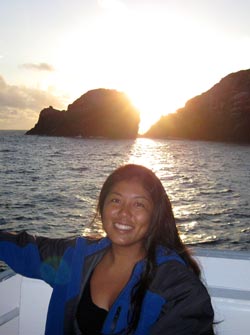
2011 Papahānaumokuākea Intertidal Monitoring Cruise Survey Team Reflections: Shauna Kehaunani Springer – Protect Papahānaumokuākea ʻOhana
Welina mai, my name is Shauna Kehaunani Springer and I was born and raised in Kaimukī, Oʻahu and have loved going to the ocean as far as I can remember. The ocean was my playground as a young girl, where I would surf, snorkel, fish and play. The ocean has always been a place of refuge for me where I could reflect and re-energize. After moving to Hilo 2002 to attend the university, the ocean became more than just a playground, it also became a place I studied. In 2006 I graduated from UH-Hilo with a BA degree in Hawaiian Studies and a minor in Marine Science. I was fortunate to get a good foundation in Hawaiian cultural knowledge while studying about the ocean. I later got a MS degree in Tropical Conservation Biology and Environmental Science in 2011 also from UH-Hilo. My master's thesis focused on the cultural use and ecology of 'opihi populations at Kalaupapa National Historical Park. All these experiences have prepared me for this intertidal monitoring trip up to Papahānaumokuākea where I hope to continue to integrate Hawaiian cultural knowledge with scientific research to eventully make more informed management decisions.
First and foremost, I wanted to bestow Papahānaumokuākea with the utmost respect and honor. Recognizing it's significance as kupuna islands is important, not only because they are geologically older but because they have experienced and seen much more than the rest. They are also very fragile islands on the verge of extinction and sinking into the abyss. Everything from the rocks to the 'opihi are fragile. The rocks crumble as you walk on them, and the 'opihi are also very fragile because their shells are so eroded.
Secondly, I hoped to re-establish my connection with Papahānaumokuākea by conducting cultural observations and integrating those with the scientific data collected on intertidal marine organisms. Utilizing all types of knowledge systems to study an environment will help us gain a holistic view of what is going on in our surroundings.
During this trip I learned so much from each and every member of our team, everyone had their own expertise. I really gained insight from the islands and the environment itself. Daily observations of the sun, moon, wind, waves and all the organisms helped me to better understand the environment in which we all live in. Everything is connected and inter-related, so this trip helped to connect a few dots although there are many more dots to connect. I also learned that the more I learn, the less I really actually know.
Some things I observed were similar to back home, but many things were different. For example living on high islands, the weather patterns are affected by the huge mountains. The environment out in the open ocean is quite different, it was amazing to see the horizon 360o arround me. The influence of fresh water in our environments back home affect the types of organisms you see or don't see in Papahānaumokuākea due to the lack of streams and rivers. The biggest difference is the absence of humans, this allows the wildlife to be truly "wild." It is amazing to see how bountiful and diverse an area can be when taken care of properly. If we play our part and keep in mind that we are a part of the environment, not separate or above it we can hopefully live sustainably within our means.
My favorite moment was when I was alone on the top deck of the boat at Mokumanamana. I was just watching all the birds circling and flying around the island, when I saw a rainbow in the distance. It started off as a small rainbow from the cloud down to the ocean, then I watched it grow as a squall came in. It finally connected to a huge rainbow over Mokumanamana. One end touched the island to one set of 'ahu, then a double rainbow appeared and touched another set of 'ahu. The wind picked up as the squall came closer, then the rain hit and slowly passed us. The squall passed behind us and it was over.
Reflecting back on my experiences on this trip, I truly feel blessed and lucky to have had this opportunity to go on this cruise. Not only because it is one of the first expeditions to truly capture what is going on in the intertidal both culturally and scientifically, but because I was able to re-connect with Papahānaumokuākea on many levels, spiritually, culturally and naturally. I am also very happy to walk away with many new friends who are more like 'ohana now since we shared many great memories and experiences and learned from each other and from the environment. I really hope that I can come back and keep my relationship alive with Papahānaumokuākea and that it will be apart of my life and my keiki's lives.
Click Here for more Survey Team Reflections.
